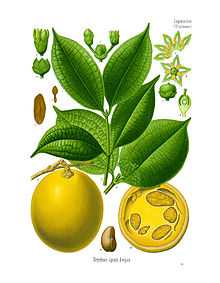Strychnos ignatii
| Ignatia | |
|---|---|
 | |
| Scientific classification | |
| Kingdom: | Plantae |
| (unranked): | Angiosperms |
| (unranked): | Eudicots |
| (unranked): | Asterids |
| Order: | Gentianales |
| Family: | Loganiaceae |
| Genus: | Strychnos |
| Species: | S. ignatia |
| Binomial name | |
| Strychnos ignatia Lindl. | |
| Synonyms | |
| |
Strychnos ignatii is a tree in the Loganiaceae family, native to the Philippines and parts of China. The plant was first described by the Czech Jesuite working in the Philippines, brother Georg Kamel who named its fruit as the Bean of St. Ignatius, after the founder of his religious order.
Etymology
The plants was originally named by Kamel for Saint Ignatius of Loyola, the founder of Kamel's Jesuit missionary order. It is known in the Philippines under the names of: aguwason, dankkagi (Visayan language) or igasud (in Cebuano language).
Fruit
The fruit of S. ignatii is the size and shape of a pear, and has almond-like seeds known as Saint Ignatius' beans.[1]
Strychnine
The beans of the plant contain the alkaloids strychnine and brucine. Strychnine is highly toxic, with an LD50 of 1-2 milligrams per kilogram, and was formerly used in rat poisons. Brucine is also toxic, but less so.
Homeopathy
The plant is the source of a homeopathic remedy known as ignatia, ignatia amara, or as samara.